Muscari spp.
With their dazzling colors, fragrance, and easy growth, bulbs make a great addition to the garden.
Take grape hyacinth, for example.
This pretty, petite bulb is a perennial spring charmer with a carefree habit, and striking colors that look fantastic in small stands or big, bold drifts.
They can be grown in beds or containers, forced indoors for winter growth, or naturalized in woodland settings.
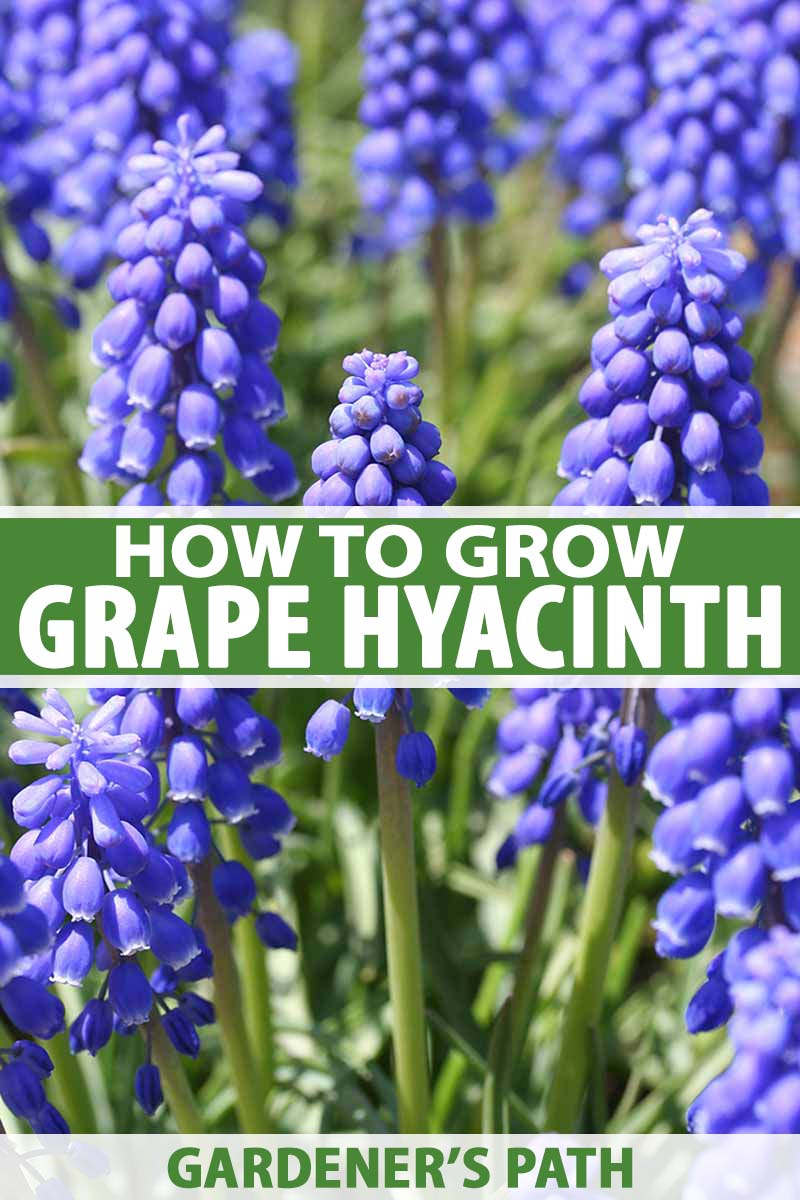
We link to vendors to help you find relevant products. If you buy from one of our links, we may earn a commission.
Reliably cold hardy, they also multiply freely, naturalizing abundantly in almost any soil type.
And their lovely, light scent on a cool spring breeze is a delight that shouldn’t be missed! Plus, they make wonderful cut flowers.
So, if you like low-maintenance plants that deliver big-time results, join us now for a look at how to grow and care for grape hyacinth.
What You’ll Learn
What Is Grape Hyacinth?
Native to northern Africa, Eurasia, and the Mediterranean basin, Muscari is a genus of perennial bulbs with approximately 40 different species.
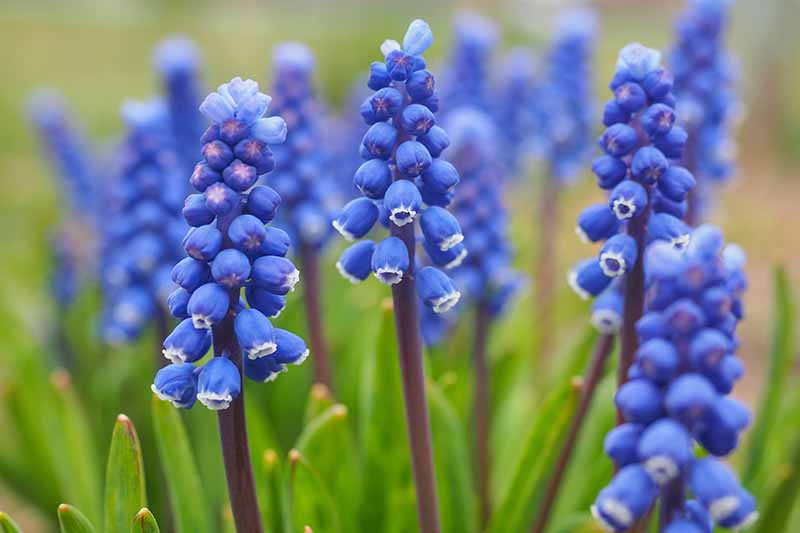
Previously classified in the lily (Liliaceae) clan, muscari species now belong to the asparagus family, Asparagaceae, subfamily Scilloideae.
Muscari bulbs are typically hardy in USDA Hardiness Zones 3 to 9 or 4 to 8, depending on the species.
Plants produce one to three flower spikes in early to mid-spring, typically growing six to 12 inches tall.
Flower racemes consist of tightly packed, urn-shaped florets that resemble a small cluster of grapes, hence their descriptive common name.
The fused tepals form a cinched, hoop-like opening, often with a thin white band around the mouth.
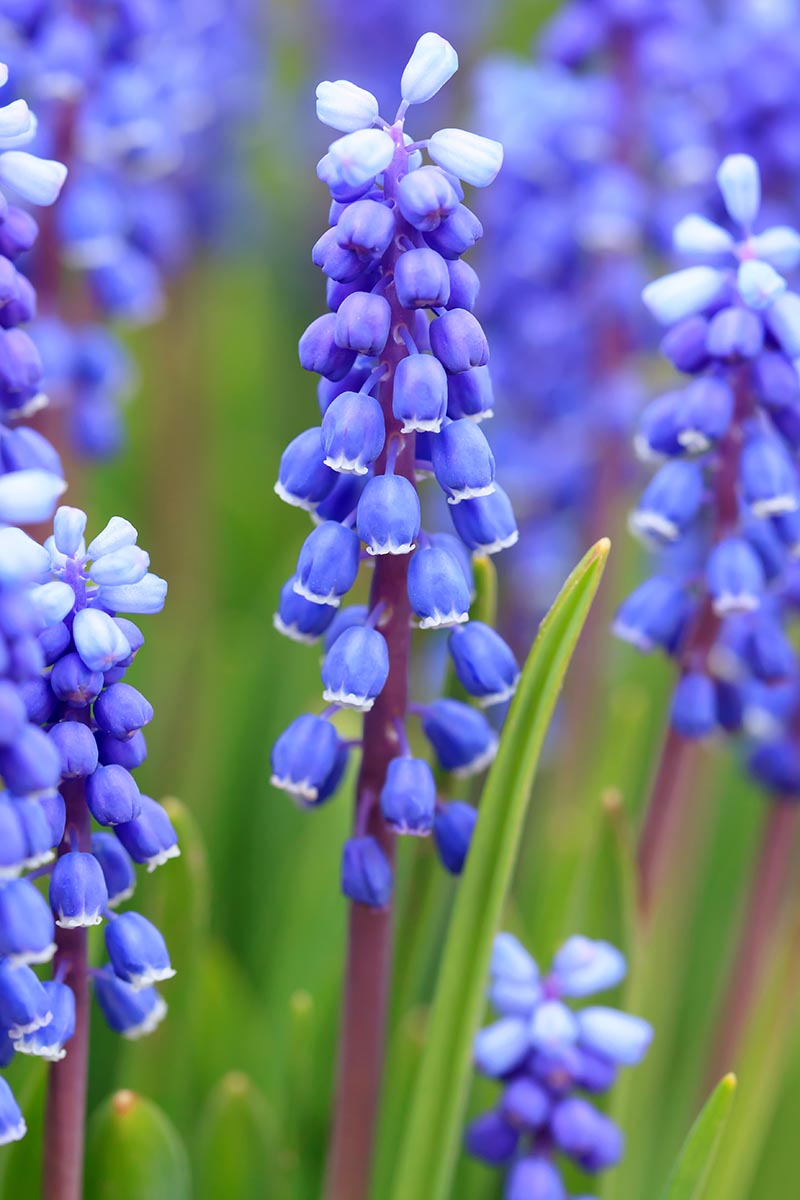
As florets open, tiny white stamen may peek out from the hoop opening.
Flowers bloom in shades of blue, purple, white, and yellow – with pale pink being a recent introduction. And some species have two-tone colors with a dark bottom and lighter top.
Although they share a common name with fragrant hyacinths, they do not belong to the same genus.

Foliage is typically narrow with an arching or slightly floppy habit, and some species send up six to eight leaves in fall.
After flowering, leaves yellow and then die back in late spring, and plants go dormant for summer.
The flowers have a light, carnation-like or slightly fruity fragrance and open from the bottom up the raceme, revealing a small fringe of tepals as florets open and mature.
Cultivation and History
The name “muscari” comes from ancient Greek and means musk, thought to refer to its scent.
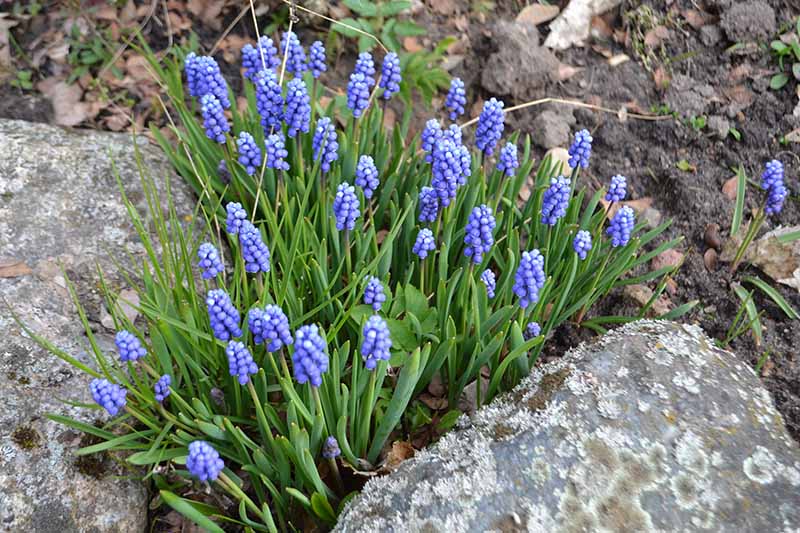
In the 14th century, bulbs traveled into Europe – north from Spain and west from the Caucasus – and have been commercially cultivated since the mid-1500s.
But archaeological evidence shows they’ve been appreciated for much longer, as far back as 50,000 years ago.
In northern Iraq, pollen analysis from a Neanderthal burial cave revealed that one man was laid to rest on a bed of branches and colorful flowers, among them grape hyacinth.
Today, grape hyacinth is renowned as the star of the stunning “blue river” at Keukenhof, a world-famous botanical garden located in Holland.
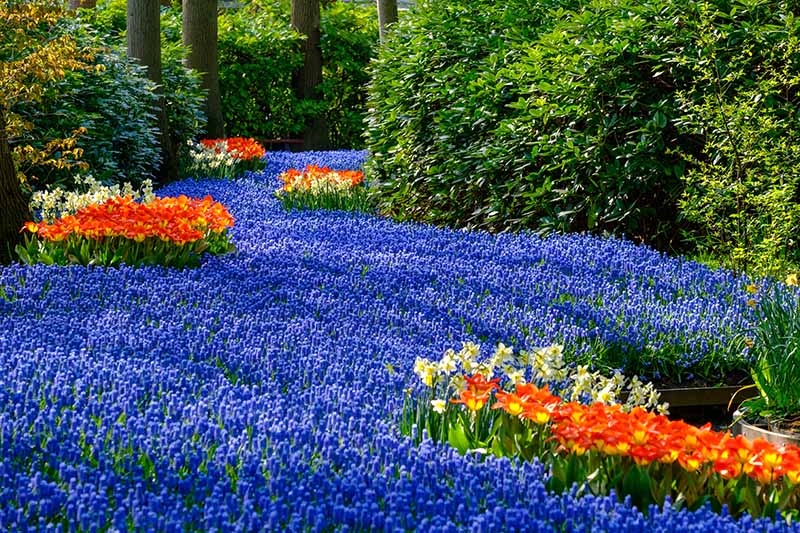
The flowers, buds, and bulbs of some species are also featured in Mediterranean cuisine, particularly in Crete and southern Italy.
The bulbs of M. comosum are boiled several times to remove bitterness, pickled, then preserved in oil and eaten as an onion substitute. And the flowers and buds of M. botryoides are pickled in vinegar for their sweet, nut-like flavor.
Muscari Plant Propagation
Muscari readily naturalize and reproduce quickly in the garden by bulb offsets and self-seeding.
However, it can take a minimum of four years for seed-started plants to set flowers. And because bulbs multiply and flower readily, offsets are the preferred propagation method.
From Seed
In summer, remove the dried seed pods to harvest seeds.
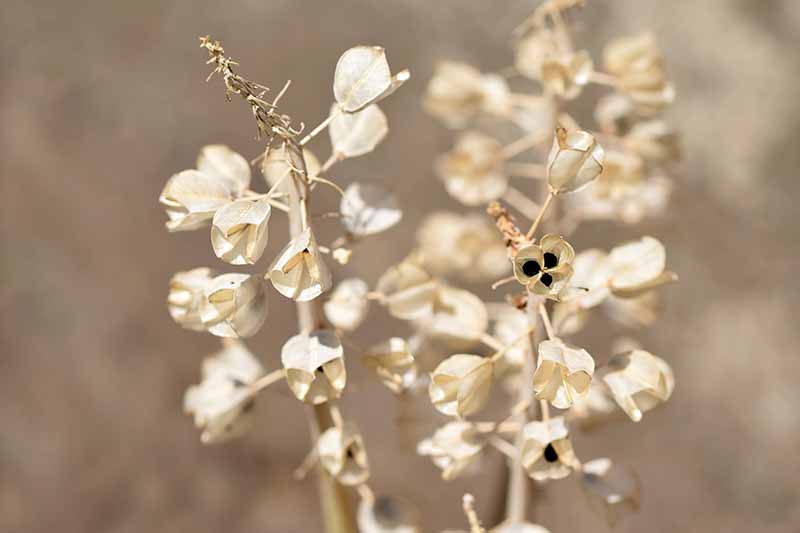
Place seeds on top of a damp paper towel and place the paper towel inside a loosely sealed plastic bag.
Place the bag in the refrigerator for up to three months to germinate. Muscari seeds require cold stratification (cold and moist conditions) to break seed dormancy.
Seeds will begin to sprout in the fridge in approximately eight to 12 weeks.
Plant out into trays of sterile garden mix and transplant into the garden after the risk of frost has passed in spring.
From Bulbs
Plant bulbs in fall or spring in large groups of 25 or more.
Generous groupings of these petite flowers are easier to see, and offer a bold visual impact. They can look sparse when planted singly or in small groups, due to their small size.
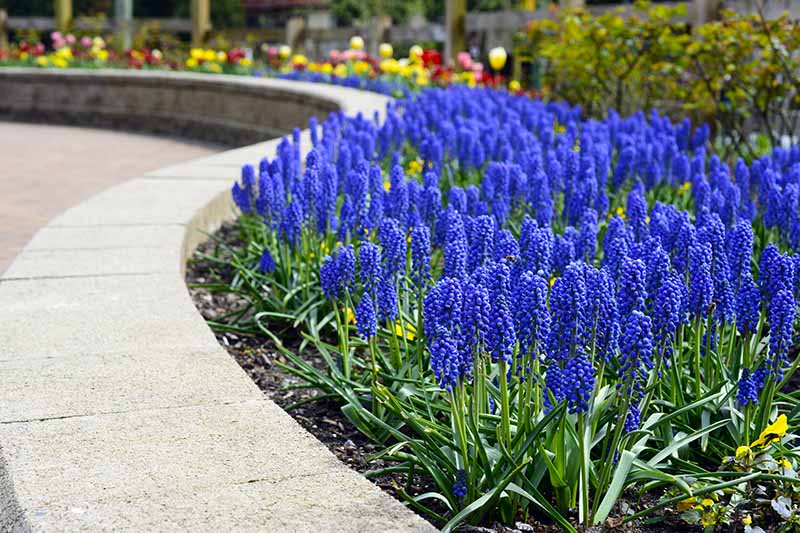
Amend your planting soil with one third organic matter such as aged compost or manure, and one third sand or fine pebble grit to improve drainage if needed.
Mix in a small amount of bone meal when planting to assist root formation.
Plant bulbs with the flat end down, one to two inches deep and spaced one to two inches apart, then backfill with soil, gently firming in place.
Water lightly to settle the bulbs.
By Bulb Offset
Clumps of muscari can be divided in very early spring before plant growth emerges, or in early fall when leaves have died back and plants are dormant.
Dig up plant clusters and gently separate offshoots from the larger bulbs.
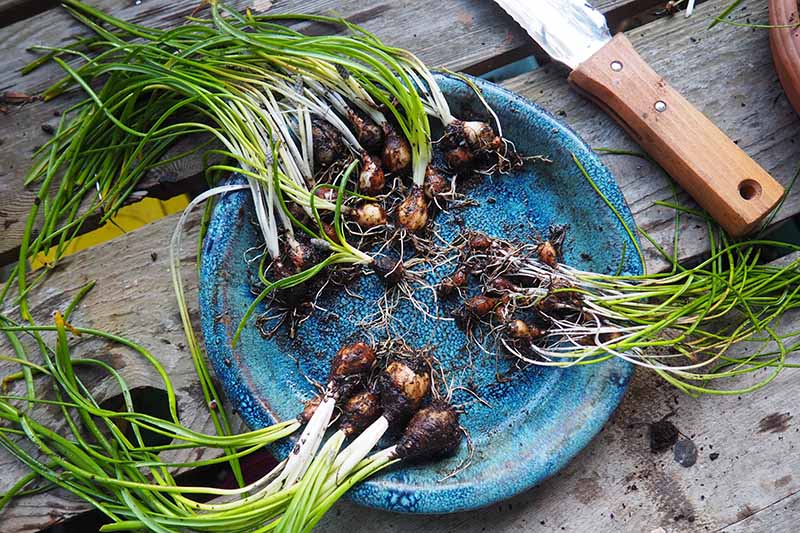
Choose the healthiest and largest bulbs and replant where desired. Mid-sized bulbs can be planted in clusters to start new clumps of flowers.
The remaining small bulbs can be tossed on bare spots, rocky slopes, or in grasses and meadows where they can grow freely.
However, use caution when tossing the discards and remember, they multiply quickly and profusely. Avoid disposing of any where you don’t want them, like in your compost bin!
Need More Propagation Tips?
Then check our our complete guide, “How to Propagate Grape Hyacinth Bulbs and Seeds.”
How to Grow Grape Hyacinth Flowers
Grape hyacinth prefers a full to partial sun location.
They like well-draining soil that’s gritty or sandy in texture, with a slightly acidic to neutral pH, and lean fertility. If you’re not sure what the composition of your soil might be, you can do a soil test.
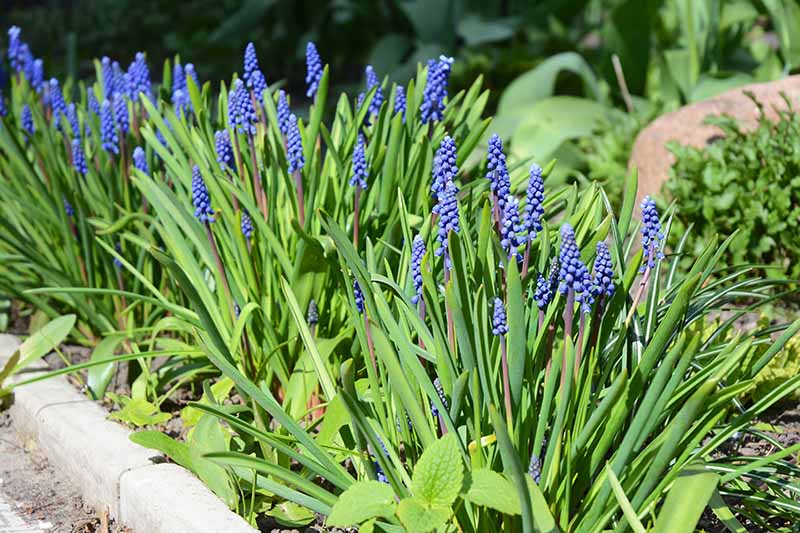
And please ensure bulbs won’t be sitting in water in winter, which can cause bulb rot.
After flowering, they require no feeding and little watering. Leaves die back and wither after setting seeds, and plants go dormant in the summer.
Many species send up foliage in the fall, but flowers don’t appear until the following spring.
After planting, muscari are self-sufficient in naturalized settings.
In beds and containers, lift and divide clumps every three to four years, or as needed. This prevents crowding and rejuvenates bulb clusters.
To divide, use a spade to loosen soil around the outside edges of clumps, then gently flip the clump upside down.
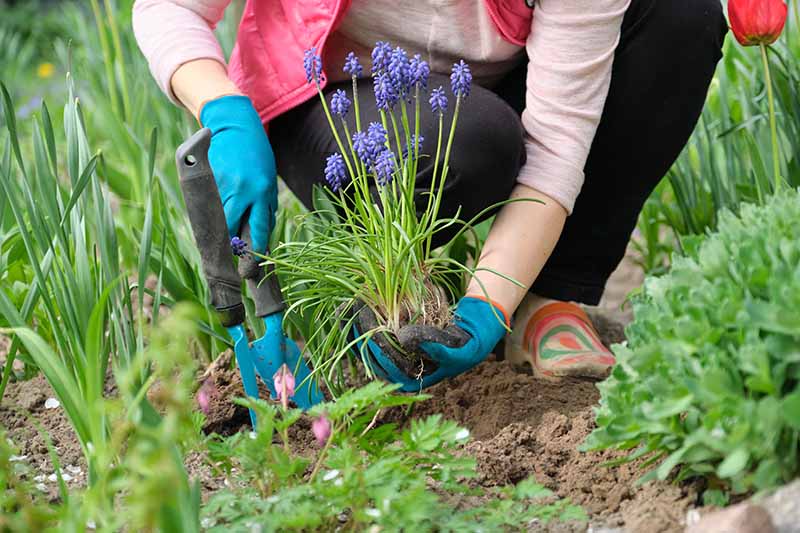
Gently pull the bulbs apart and replant the largest ones.
Use midsized offsets to start new clusters, and dispose of the smallest specimens, or scatter them around the planting area as you wish.
For container growth, use a well-draining soil amended as described above, and ensure containers have adequate drainage to prevent bulbs from sitting in water.
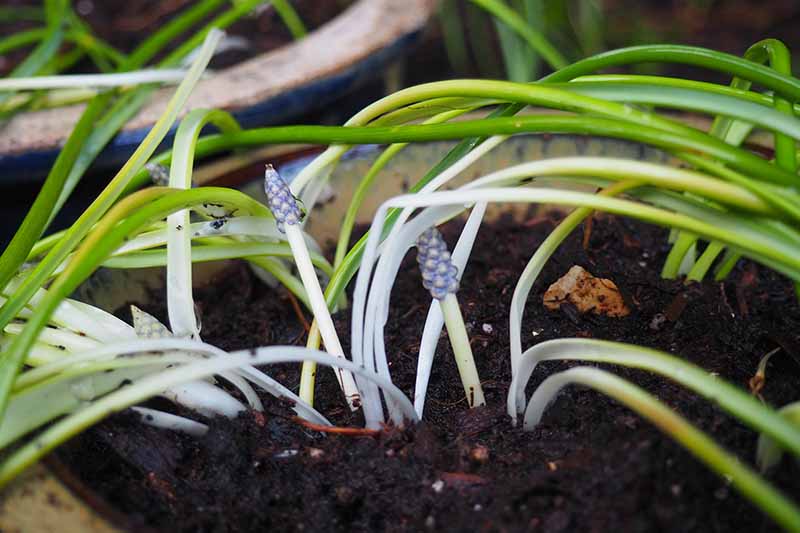
Pack bulbs slightly closer than you would when planting in the ground. A pot that’s six inches in diameter and six inches deep can hold eight to 12 bulbs.
Forcing Indoor Bulbs
Forcing muscari to bloom indoors is easy, and you’ll love the color and fragrance they add to a winter window.
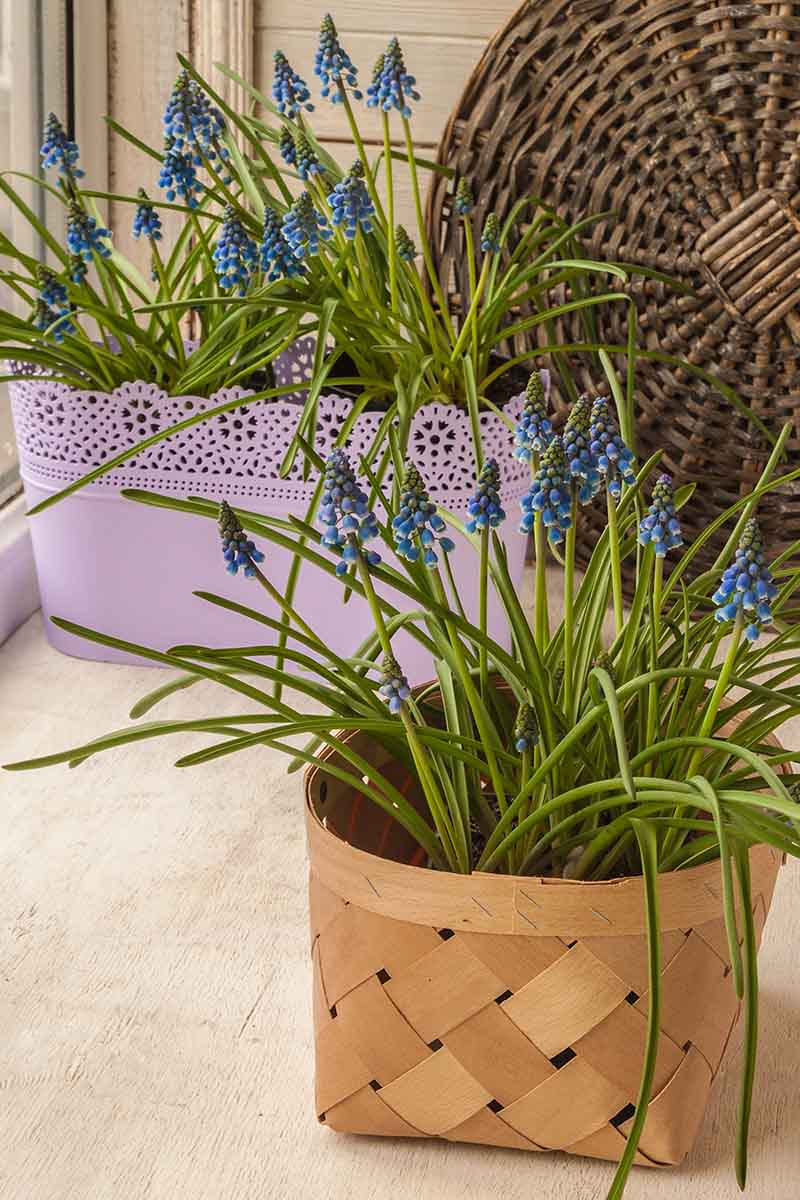
In late summer or early fall, purchase bulbs or dig some up from the garden.
To enjoy a bloom period of January through March, chill successive pots of bulbs beginning in September and continue through October.
Then chill pots for a period for 10 to 12 weeks at temperatures of 35 to 48°F.
Use moist, sterile potting mix and replace a quarter of the soil with coarse sand to aid drainage. Ensure pots are free draining as well.
Space bulbs closely, about a half to one inch apart, in containers that measure six to eight inches deep and six to eight inches in diameter.
Plant 12 to 15 bulbs closely together, one to two inches deep, with pointed tips facing upward.
Chill in a cool, dark location like an unheated cellar or garage, cold frame, or spare refrigerator.
Water bulbs lightly every week, just enough to keep the soil lightly moist but not wet.
After their chill period, or when roots begin to emerge from pot bottoms, move pots to a brightly lit, cool spot to encourage flowers. A maximum daytime temperature of 65°F is ideal.
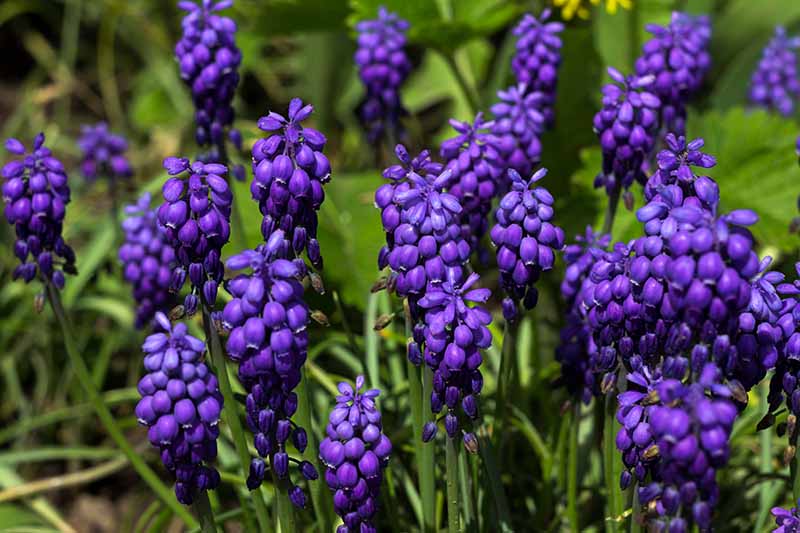
Keep the soil moist until plants finish flowering. When leaves start to die back, move pots outside, or transplant bulbs into the garden for summer dormancy.
Plant up several pots at once, or stagger your timing and plant and chill pots of bulbs at one-week intervals to enjoy a longer display time.
Growing Tips
Care for these charming little flowers is basic, and the following tips will ensure they enjoy the best conditions.
- Excellent drainage is a must. These bulbs don’t fare well if allowed to sit in water over winter.
- Overly rich soil produces more foliage and less flowers, and muscari prefer lean soil. Adding compost when planting in-ground is all they require for feeding.
- Container plants will benefit from a light feeding of a granular 5-10-5 fertilizer lightly scratched into the soil before blooming. Allow spring rains to wash nutrients toward the roots.
- Keep the soil moist in spring and reduce watering after plants finish flowering.
After-Bloom Care and Maintenance
Wonderfully low maintenance, muscari bulbs require little care.
Foliage withers and dies back in late spring. Clean up dead leaves with a small hand rake once they’ve dried and turned brown.
These bulbs require no supplemental feeding in beds, but container plants appreciate a light feeding of a granular 5-10-5 fertilizer in late winter before blooming.
Muscari Cultivars to Select
There are plenty of sweet grape hyacinth choices available to home gardeners. Shop at your local garden center, bulb specialty houses, or online.
Here are a few of our favorites:
Dark Eyes
‘Dark Eyes’ is a hybrid cross between M. aucheri, M. neglectum, and M. pallens, and is prized for its densely packed, uniform flowers of deep sapphire blue and a light, sweet fragrance.
Deer resistant, they thrive in Zones 4 to 8 in full or part sun, and they are tolerant of most types of soil. ‘Dark Eyes’ grows to a height of four to eight inches with a spread of three inches.
Bags of 15 bulbs are available at Burpee.
Delft Blue Mix
‘Delft Blue Mix’ deftly displays the large flower heads and full spectrum of colors of M. armeniacum in bright shades of baby blue, cobalt, white, and two-tones.
Reaching heights of up to eight inches, they’ll do well in sun to partial shade in Zones 3 to 8.
Eden Brothers carries bags of 25, 50, and 100 bulbs.
Pink Sunrise
‘Pink Sunrise’ is a hybrid cultivar with delicate, baby-pink blooms on seven-inch stems.
Suitable for growing in Zones 4 to 8, ‘Pink Sunrise’ would look delightful interplanted with white and blue cultivars.
White Magic
‘White Magic’ is an M. aucheri cultivar that features pure white flowers on tall, 12-inch stems and a light, fruity fragrance.
This type is suitable for growing in Zones 3 to 8.
You can find ‘White Magic’ in packages of 10 via Walmart.
Want More Choices?
Be sure to check out our supplemental guide, “9 of the Best Grape Hyacinth Varieties for Your Garden.”
Managing Pests and Disease
Grape hyacinth has few common problems.
Aphids and spider mites are the most common pests, though infestations are rare. Remove insect pests with a strong spray of water from the garden hose.
Yellow mosaic virus can also make an appearance.
Typically spread by insects like aphids, symptoms can include yellow or light green patterns on the leaves and growth suppression.
Bulbs infected with viral disease should be dug out and destroyed to prevent spreading the infection.
Best Garden Uses for Grape Hyacinth Flowers
These highly versatile bulbs are naturally found in woodlands and meadows, making them ideal for any naturalized setting.

They’re also commonly cultivated in beds, borders, containers, lawns, and rockeries, under deciduous trees, and around shrubs.
Muscari provides spectacular drifts of color when mass planted and mixes well with other early flowering bulbs like anemones, daffodils, and tulips.
Bulbs can be forced indoors for winter blooms, and taller varieties make lovely cut flowers as well.
Quick Reference Growing Guide
| Plant Type: | Flowering bulb | Flower / Foliage Color: | Blue, pink, purple, white, yellow; green |
| Native to: | North Africa, Eurasia, Mediterranean | Maintenance: | Low |
| Hardiness (USDA Zone): | 3-9 for M. botryoides, 4-8 for most other species | Tolerance: | Deer, rabbit, rodents |
| Bloom Time / Season: | Early to mid-spring | Soil Type: | Average fertility |
| Exposure: | Full to partial sun | Soil pH: | 6.1-7.5 |
| Time To Maturity: | Up to 4 years from seed, 2 years from bulb offset | Soil Drainage: | Well-draining |
| Spacing: | 1-2 inches | Companion Planting: | Other spring bulbs |
| Planting Depth: | 2-3 inches | Uses: | Beds, borders, containers, naturalized settings |
| Height: | 6-12 inches | Family: | Asparagaceae |
| Spread: | 4-8 inches | Subfamily: | Scilloideae |
| Water Needs: | Moderate in spring, low in summer | Genus: | Muscari |
| Attracts: | Bees, butterflies, and other pollinators | Species: | Approximately 40 species including aucheri, armeniacum, azureum, botryoides, comosum, macrocarpum, neglectum, pallens, paradoxum, plumosum |
| Common Pests: | Aphids, spider mites | Common Disease: | Yellow mosaic virus |
Plant and Forget? Perfect!
Easy to grow, low maintenance, and hardy, these cheery flowers are perfect for plant-and-forget convenience.
Completely reliable, they never fail to add a gorgeous pop of color to the early spring garden. And you’ll love the way clumps multiply, adding more blooms every year!
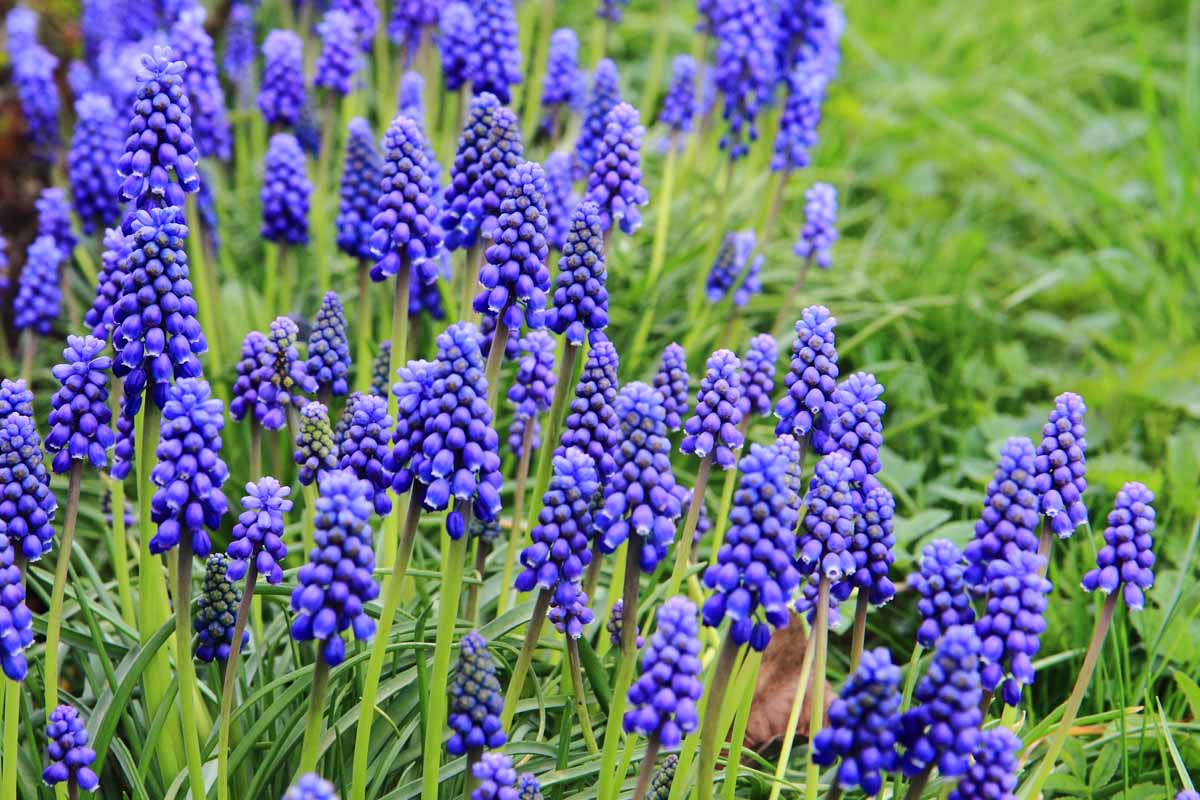
Do you folks have a favorite Muscari species or cultivar to recommend? Drop us a line in the comments below.
And be sure to check out some of our other spring flower favorites – here are a few that might interest you:
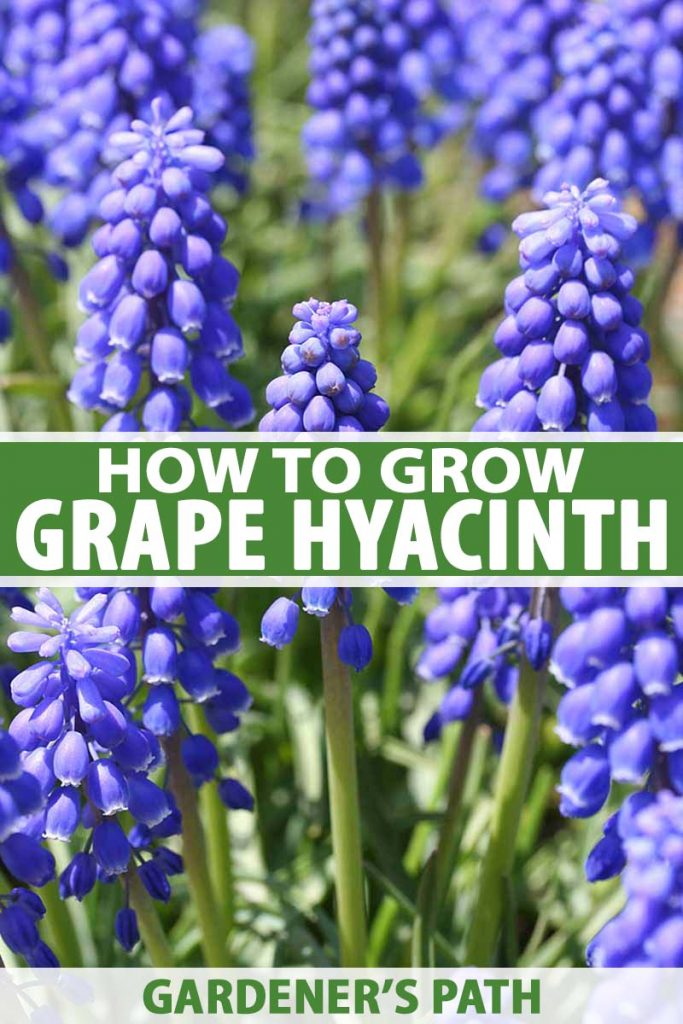
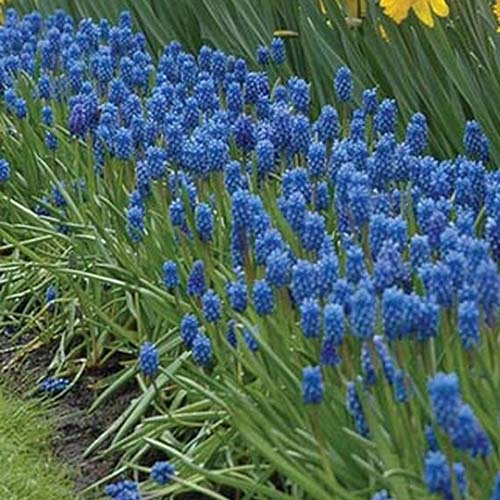
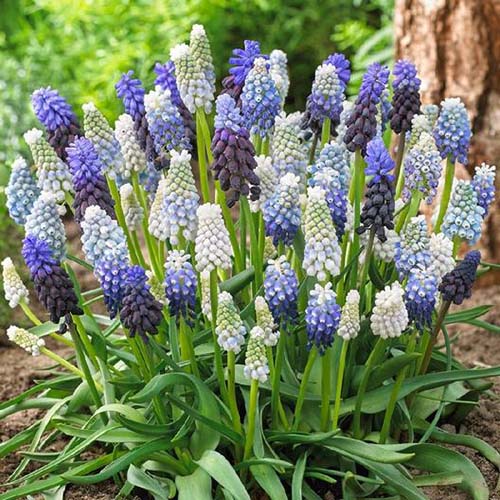

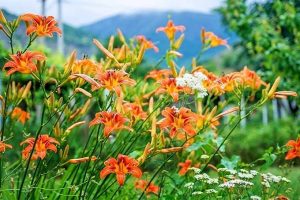
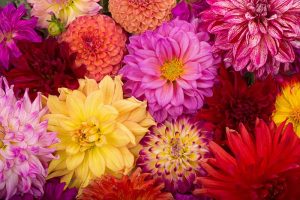
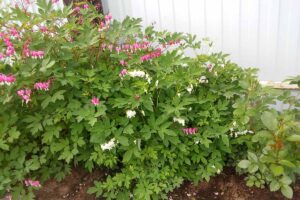
Just transplanted grape hyacinths from son’s yard as they are extending their patio and will be digging up the flower bed. To my surprise, I found two clumps laying over to discover bulbs have been eaten. Was it the chipmunks, squirrels, or toad in the yard?
That’s a surprise Patti, my references always list muscari as being pest free, including rodents.
And personally, I’ve never had a problem with squirrels or chipmunks eating them in my garden – ‘tho they dig up other bulbs.
The most common culprits for destroying bulbs are chipmunks, gophers, squirrels, and voles.
But, if a critter’s hungry enough, I’m sure they’ll eat anything.
Hopefully, this was an isolated incident… thanks for your question!
I just harvested seeds from the dried seed pods. It’s July. When and how can I plant them in ground?
That’s great, Barbara! See the section of the article above on propagating grape hyacinths from seed – collected seeds can be stored in a cool, dry, dark place before cold stratifying as we’ve described for three months, and then seedlings can be grown indoors. Seedlings can be hardened off and transplanted out into the garden after the risk of frost has passed in your area in the spring. Seeds could be sown directly in the ground, but it’s easier to control temperature/moisture levels and give them a good start by cold stratifying in the fridge and then planting the sprouted… Read more »
I have unplanted bulbs, I am a very newbie gardener and I don’t know how to keep them until autumn to plant. Is it okay if I plant them in February and wait until next year for them to flower, or is there a way to keep the bulbs safe until autumn (which is the right time to plant)? Thanks in advance.
Hey kuzey, yes, go ahead and plant your bulbs in February, it’s much better than storing them until fall.
You’ll get a few flowers this year, but most of the growth will be foliage – flowers will be more prolific in the second year and increase after that.
Thanks for asking!
I just found a bag of muscari that was hidden in my coat closet. Should I plant the bulbs now, or should I put them in the fridge and wait until Autumn? Thank you!
Hey Amaryllis, go ahead and plant your bulbs now, or as soon as the ground can be worked. You may not get flowers this year, but they’ll be back on track by next spring.
Thanks for asking!
I live in zone 8a,8b. What other plant would go good along with the grape hyacinth in a flower bed? Will the blooms die out at the end of Spring?
Hi Cindymt, muscari does well with other spring bloomers such as bergenia, crocus, daffodils, hellebore, creeping phlox, and tulips.
And yes, the flowers bloom for 3-4 weeks then blooms die out by the end of spring and folliage dies back by summer.
To avoid bare spots after they’ve finished flowering, overseed the area in mid to late spring with fast growing annuals such as bachelor’s button, marigolds, nasturtiums, portulaca, or zinnia.
Hope that helps and thanks for asking!
Is it possible for the grape hyacinth bulbs to mutate and bloom in a different form? I got some bulbs from a friend’s garden. We both planted them (she said they’ve always bloomed as grape hyacinths do) but this year we both have a taller plant with drooping star-shaped flowers, not tightly packed little bells. She said she thought this year’s bulbs were larger than usual too. Do the age-out? I’m mystified.
This is what bloomed from my friend’s grape hyacinth blubs that she divided. Too much fertilizer?
Hey Janet, thanks for the photo.
I don’t think your friend’s bulb is Muscari – with the spacing and shape of the flowers, it looks more like a variety of bluebell, Hyacinthoides – another charming bloomer in the spring garden!
The foliage is quite similar, but bulbs are a bit bigger than muscari and white in color with no papery tunic. The bulbs can also take on odd shapes, including round, elongated, and hourglass forms.
Hope that helps, thanks for asking!